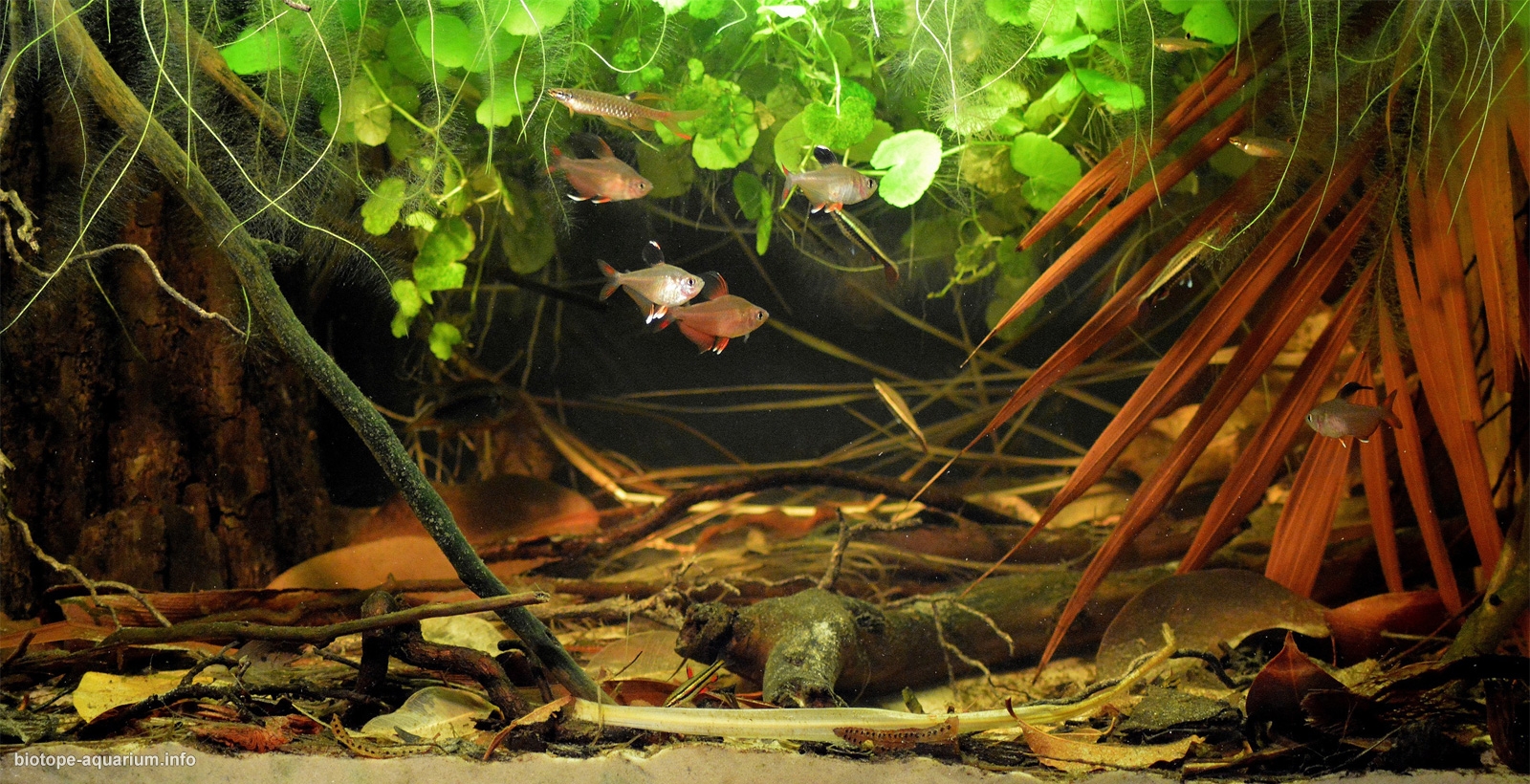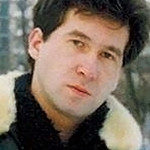Coastal part of clear-water stream in Alenquer area, Para state, Brasil
25th place in Biotope Aquarium Design Contest 2017
![]() Russia. Alexander Dergalev
Russia. Alexander Dergalev

Volume: 72 L
Dimensions: 60x30x40 cm
List of fishes: Copella arnoldi (1 male + 2 female + 3 juveniles), Nannostomus marginatus (2 male + 3 female), Nannostomus eques (4 males + 1 female), Hyphessobrycon bentosi (3 males + 2 females), Apistogramma cf. agassizii Netz/Net – Alenquer (1 male + 1 female), Hemiloricaria lanceolata (1 male + 1 female)
List of plants: Limnobium laevigatum, Hydrocotyle leucocephala, Lemna minor (cosmopolitan)
Description of decorations: The ground consists of white quartz sand UDeco River Light 0.1-0.6 mm. The fallen leaves of tropical plants were collected in the botanical garden of Batumi, as well as in a greenhouse. Branches, driftwood and bark of leaf trees were collected in the wild.
Description of equipment: Sobo WP1770 submersible pump (400 l/h) with big sponge (hidden in a “tree trunk”). 2 x 75W incandescent lamps, 13W fluorescent lamp. Aquael Easy submersible heater 50W (when necessary).
Water parameters: Temperature is 24-28°C, pH is 6.0-6.5, conductivity is 20 µS/cm (revers osmosis water, GH = 0).
Description of the area surrounding the biotope: The surroundings of the Alenquer municipality in Brazil is a fairly typical terrain in the lower reaches of the Amazon. In these flat places, the banks of the giant river are heavily indented, forming a large number of wide creeks and lakes, such as Lago Grande and Lago Cuipeua (a known place for catching and export of discus fish). These rivers flow into rivers and streams of different sizes, the coastal part of one of which I tried to recreate in my aquarium. Due to the fact that Alenquer is located quite close to the Atlantic coast of Brazil, this area has long been quite accessible to people, and therefore the area around Alenquer long ago began to be cultivated. As a result, a significant part of primary rain forests was reduced, and now the place is occupied by secondary tropical forests consisting of ruderal plants or agricultural lands. Seasonality in these places is the change of dry season to wet season, during which the water level in local water bodies rises.
Description of the underwater landscape of the biotope: The landscape of the biotope I recreated is quite typical for small streams and rivers in the Amazon: on the bottom there is a fine white sand on the surface of which vegetative litter accumulates. In the coastal parts of the stream there are many roots of trees, fallen branches and tree stumps. As the river flows through farmlands and secondary forests, there are not so many leaves of tropical trees on its bottom, but quite a lot of plant litter from monocotyledonous plants, in particular, from palm trees brought into this locality. The depth of such rivers and streams is small, so large fish do not live there. Vegetation is represented mainly by floating plants, locally forming a dense “carpet” on the water surface. The thickets of floating plants leave little light to the plants growing on the bottom, they are mainly represented by the Nymphaea genus. Overhanging plants over the water serve as spawning place for Copella arnoldi.
Description of the parameters of the habitat: The water is transparent with yellow colour due to the moderate content of tannins, the concentration of which can vary at different times of the year. The pH is about 6.5, the conductivity reaches 19 μS/cm, and the temperature is usually close to 26°C. In the coastal parts of the stream there are many roots of trees, fallen branches and tree stumps.
List of fishes: Apistogramma agassizii, Apistogramma geisleri, Crenicichla cf. regani, Acaronia nassa, Hyphessobrycon bentosi, Hyphessobrycon heterorhabdus, Hemigrammus ocellifer, Hemigrammus cf. hyanuary, Hemigrammus armstrongi, Bryconops melanurus, Nannostomus unifasciatus, Nannostomus eques, Nannostomus marginatus, Nannostomus beckfordi, Copella arnoldi, Carnegiella strigata, Chilodus gracilis, Potamorrhaphis guianensis, Monocirrhus polyacanthus, Loricaria simillima, Hemiloricaria lanceolata, Ancistrus dolichopterus. In the fish fauna, there are 3 main groups: Cichlids, Characiniformes and Loricaria. Among the Characin-like, the Lebiasinidae family mostly inhabit the upper layers of the water, the members of the Characin tetra family keep in the middle layers, while the cichlids (in this case Apistogramma) prefer to keep closer to the bottom, feeding by sifting the sandy soil through the gills. Loricaria catfish keep on surfaces: driftwood, plant leaves, bottom surface, feeding mainly on bacterial and algal overgrowths (and sometimes also on wood itself: the Panaqolus genus), and also small invertebrates.
List of plants: Pistia stratiotes, Limnobium laevigatum, Salvinia molesta, Utricularia sp., Azolla caroliniana, Ludwigia helminthorrhiza, Nymphaea sp.
Sources of information: Since an exact and direct description of the streams in the area I recreated was not found, the aquarium was prepared using information on typical forest streams in the State of Para, as well as on lakes Grande and Cuipeua.
- http://sekaiscaping.blogspot.com/2008/12/expedio-em-igarap-miri.html
- http://www.aquapress-bleher.com/interzoo-2008-biotope-2/
- https://www.youtube.com/watch?v=cTMtnLCwIlY
- https://www.youtube.com/watch?v=sBOZ0c5wSbo
- Copella arnoldi: http://www.fishbase.org/summary/Copella-arnoldi.html, http://www.seriouslyfish.com/species/copella-arnoldi/
- Hyphessobrycon bentosi: http://www.seriouslyfish.com/species/hyphessobrycon-bentosi/, http://maps.iucnredlist.org/map.html?id=167807
- Nannostomus marginatus: http://www.fishbase.se/summary/Nannostomus-marginatus.html, http://www.seriouslyfish.com/species/nannostomus-marginatus/
- Nannostomus eques: http://www.fishbase.se/summary/Nannostomus-eques.html
- Apistogramma cf. agassizii Netz/Net – Alenquer http://apisto.sites.no/page.aspx?PageID=118, http://apisto.sites.no/fish.aspx?fishIndexID=2440&gruppeID=1
- Mike Wise (ichtyologyst, apistogramma specialist) post on this resourse, https://apistogramma.com//forum/threads/apistogramma-cf-agassizii-alenquer.9883/
- Hemiloricaria lanceolata: https://www.planetcatfish.com/common/species.php?species_id=739, http://www.seriouslyfish.com/species/rineloricaria-lanceolata/
- Limnobium laevigatum: https://en.wikipedia.org/wiki/Limnobium_laevigatum
- Hydrocotyle leucocephala: http://www.aquaticplantcentral.com/forumapc/plantfinder/details.php?id=146, http://diszhal.info/english/plants/en_Hydrocotyle_leucocephala.php
- Lemna minor: https://en.wikipedia.org/wiki/Lemna_minor
Comments of the members of the jury of Biotope Aquarium Design Contest 2017

It is a perfect combination of not large tetras, apistogrammas and a loricarias for a small aquarium. It is clean, neat with the moderate presence of organic matter. Fishes behave naturally.
